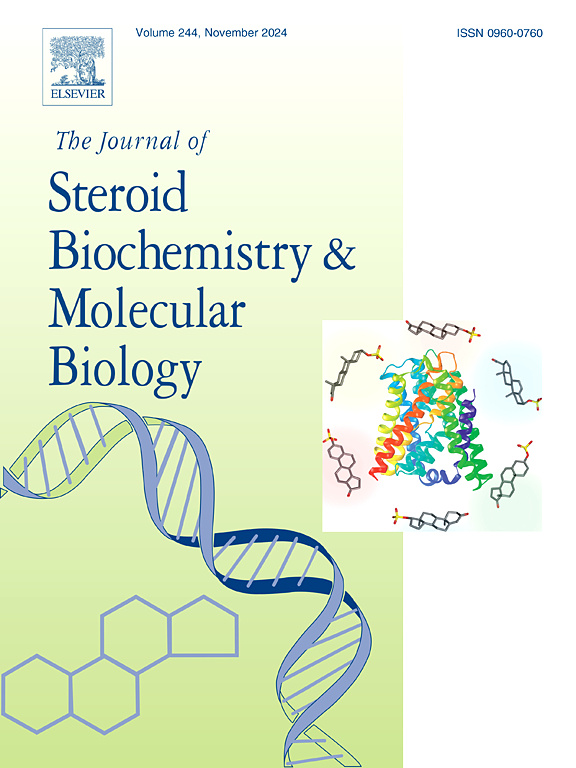Zingerone modulates the circulating steroids hormone levels and testicular steroidogenic markers expression in mice: An in vivo and in silico study
IF 2.7
2区 生物学
Q3 BIOCHEMISTRY & MOLECULAR BIOLOGY
Journal of Steroid Biochemistry and Molecular Biology
Pub Date : 2025-04-04
DOI:10.1016/j.jsbmb.2025.106748
引用次数: 0
Abstract
Zingerone (4-(4-hydroxy-3-methoxyphenyl)-2-butanone) is a phytochemical with potent anti-inflammatory and antioxidant properties. It has been shown that zingerone protects testis under pathological conditions by its antioxidant and anti-inflammatory effects. However, there is no direct evidence that zingerone specifically affects the testicular steroidogenesis in normal conditions. Therefore, in this study, we have investigated the effects of zingerone on testicular steroidogenesis by using in vivo and silico approaches. The mice were divided into four groups: Control, 10, 25, and 50 mg/kg dosages of zingerone, which were administered orally for 35 days. It was observed that zingerone treatment modulates both circulating hormone levels and the expression of steroidogenic protein markers. Specifically, the higher doses of zingerone resulted in an increase in the circulating estrogen and androstenedione levels, while progesterone, testosterone, and follicle-stimulating hormone levels were reduced. Further, no significant change was observed in the circulating LH level. The higher doses of zingerone resulted in an increased expression and localisation of 3βHSD, CYP19A1, LHR and decreased expression and localisation of StAR, CYP11A1, and 17βHSD protein. Our silico studies showed that the steroidogenic proteins (CYP11A1, 3βHSD, 17βHSD) when double docked with zingerone alongside its native ligands (cholesterol, pregnenolone, androstenedione) showed an increase in the binding affinity. In contrast, StAR, CYP19A1 when double docked with zingerone and its native ligands exhibited a lesser binding affinity compared to when these proteins were single docked with their native ligand and zingerone. In conclusion, in vivo study showed zingerone stimulates androstenedione, estrogen secretion and up-regulates the expression of CYP19A1, LHR and 3βHSD proteins, whereas it down-regulates the expression of StAR, CYP11A1 and 17βHSD proteins and circulating testosterone, progesterone, follicle-stimulating hormone levels. Furthermore, in silico study has also shown the binding affinities of zingerone with the steroidogenic markers. Thus, zingerone has modulatory effects on testicular steroid biosynthesis in normal mice.
姜酮调节小鼠循环类固醇激素水平和睾丸类固醇生成标记物表达:体内和计算机研究
姜酮(4-(4-羟基-3-甲氧基苯基)-2-丁酮)是一种具有有效抗炎和抗氧化特性的植物化学物质。研究表明,生姜酮通过其抗氧化和抗炎作用在病理条件下保护睾丸。然而,没有直接证据表明生姜酮在正常情况下特别影响睾丸甾体生成。因此,在本研究中,我们采用体内法和硅法研究了生姜酮对睾丸甾体生成的影响。将小鼠分为4组:对照组、10、25、50 mg/kg剂量组,连续口服35 d。观察到姜酮处理可调节循环激素水平和类固醇蛋白标记物的表达。具体来说,高剂量的姜酮导致循环中的雌激素和雄烯二酮水平增加,而孕酮、睾酮和促卵泡激素水平降低。此外,循环LH水平未见明显变化。高剂量姜酮导致3βHSD、CYP19A1、LHR蛋白的表达和定位增加,而StAR、CYP11A1和17βHSD蛋白的表达和定位降低。我们的硅研究表明,当与生姜酮及其天然配体(胆固醇、孕烯醇酮、雄烯二酮)双对接时,类固醇原蛋白(CYP11A1、3βHSD、17βHSD)的结合亲和力增加。相比之下,StAR、CYP19A1与生姜酮及其天然配体双对接时,与这些蛋白与其天然配体和生姜酮单对接时,其结合亲和力较低。综上所述,体内实验表明,生姜酮刺激雄烯二酮、雌激素分泌,上调CYP19A1、LHR、3βHSD蛋白表达,下调StAR、CYP11A1、17βHSD蛋白表达及循环睾酮、孕酮、促卵泡激素水平。此外,在硅片上的研究也显示了姜酮与甾体生成标记物的结合亲和力。因此,姜酮对正常小鼠睾丸类固醇生物合成具有调节作用。
本文章由计算机程序翻译,如有差异,请以英文原文为准。
求助全文
约1分钟内获得全文
求助全文
来源期刊
CiteScore
8.60
自引率
2.40%
发文量
113
审稿时长
46 days
期刊介绍:
The Journal of Steroid Biochemistry and Molecular Biology is devoted to new experimental and theoretical developments in areas related to steroids including vitamin D, lipids and their metabolomics. The Journal publishes a variety of contributions, including original articles, general and focused reviews, and rapid communications (brief articles of particular interest and clear novelty). Selected cutting-edge topics will be addressed in Special Issues managed by Guest Editors. Special Issues will contain both commissioned reviews and original research papers to provide comprehensive coverage of specific topics, and all submissions will undergo rigorous peer-review prior to publication.

 求助内容:
求助内容: 应助结果提醒方式:
应助结果提醒方式:


